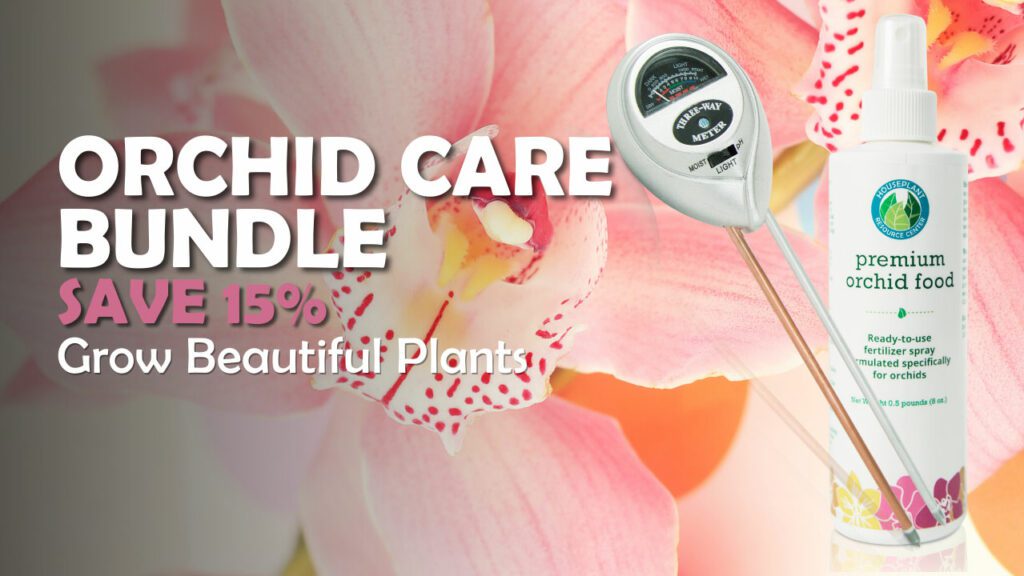Like all flowering plants, orchids bloom in cycles. During flowering season, your orchid will begin to show new buds that eventually unfold into big, bountiful flowerheads.
After a few weeks, your orchid’s flowers will naturally drop and your plant will go into a necessary dormant period to store up energy for its next bloom.
While it may seem easiest to leave your plant alone during its months of hibernation, there is one necessary and often overlooked step to ensure your plant makes it through the winter months ready to boast hearty blooms come next flowering season.
That important step is called pruning your orchid.
Let’s take a deeper dive into the process of orchid pruning so you’re fully prepared to trim your plant and set it up for a show-stopping springtime bloom.
What is pruning and why is it important?
Pruning is the process of removing weak or unhealthy parts of your orchid, so your plant makes new, heartier ones instead. By removing old or weak spikes, you can ensure your orchid concentrates its energy into producing new spikes and shoots, which leads to an overall healthier plant that boasts big blooms and thick, green leaves.
When is the best time to prune an orchid?
If your orchid blooms in spring or early summer—as is typical across most indoor orchid species—prune your orchid during fall months.
You’ll be able to tell when your plant is transitioning into a dormant period by observing its blooms. When all blooms have fallen from your plant, it’s time to prune.
Step #1: Prepare Your Workstation
When pruning your orchid, you’ll want to set up your workstation before you get started. This will help keep the process quick and tidy.
Stock your workstation with:
- A pair of sharp shears to make clean cuts
- A pair of gloves to keep your hands from getting dirty
- Some extra potting mix for freshening up your orchid’s pot
Professional Tip: Before you get started, be sure to sterilize the blades of your shears with hot soapy water so as to avoid introducing germs to your plant when you’re cutting back its stems.
Step #2: Choose Which Spikes to Prune
When pruning your orchid, you’ll want to cut back weak spikes while leaving healthy ones intact.
To identify which spikes to cut back, look for spikes that are brown or yellow in color. Spikes that appear mushy or look to be wilting are also good candidates to be cut back.
Professional Tip: Some orchids are single-spiked and others are double-spiked. Research your orchid type before beginning the trimming process so you don’t accidentally trim away necessary parts of your plant.
Step #3: Prune Your Orchid
Now that you’ve set up your workspace and identified the spikes you’ll prune back, it’s time to get to work.
When trimming brown or yellow spikes, cut all the way back to the base of the plant to encourage full regrowth. Use the same process for trimming mushy or wilting spikes too.
If you choose to trim back healthy spikes to encourage new growth, cut the spike 1 inch above its lowermost flower node.
Professional Tip: When trimming, make sure your shears are sharp. This will ensure your cuts are clean and encourage proper plant healing.
Step #4: Keep Your Orchid Healthy
After you’ve trimmed your orchid’s unhealthy stems, refresh its soil, give it a good drink, and position it in plenty of indirect sunlight.
If your orchid’s foliage is green and vibrant, return it to its original position. If your plant’s foliage looks burnt at the edges, a bit flimsy, or otherwise unhealthy, try repositioning your plant in a spot more suitable to orchid growth.
Professional Tip: Don’t forget to put your orchid on a humidity tray and keep it away from air vents.
Step #5: Use an Orchid Fertilizer
Your orchid needs food and nourishment to thrive indoors, even during the winter months when your plant goes dormant. Often, regular fertilizers can be too harsh and burn your plant, so be sure to use a gentle feed that’s specially designed for your orchid.
A regular fertilizer routine will keep your orchid hearty and healthy and will ensure that your plant is ready to burst into flower come flowering season.
Professional Tip: If you’re looking for the perfect orchid fertilizer, we recommend our easy-to-use Premium Orchid Food. We’ve diluted the standard orchid fertilizer ratio so you can safely fertilize your orchid at every watering without burning its roots. Our fertilizer spray is formulated to supply the correct nutrients to your orchids and requires no mixing or measuring. Just spray and watch those blooms explode!
Recap: How to Prune Your Orchid
There you have it. A complete 5-step guide to pruning your orchid so you can keep your plant happy and healthy all year round.
Here’s a quick recap of the steps to pruning your orchid and some links to the supplies you’ll need to get started:
- Prepare your workstation with a pair of sharp shears, a pair of gloves, and extra potting mix for refreshing your plant’s soil.
- Choose which spikes to trim back by identifying brown, yellow, or mushy stems.
- Trim unhealthy spikes back to the plant’s base, and trim healthy stems back to 1 inch above their lowest flower node.
- Position your plant in a spot that’s suited to provide optimal temperature and light conditions for your orchid.
- Use an orchid fertilizer every time you water to help keep your plant thriving, even in the dormant winter months.
If you’re looking to join a community of orchid lovers like yourself, pop into our Facebook community where you can ask questions, share photos, and keep us posted on your orchid’s full bloom progress come next bloom season.



